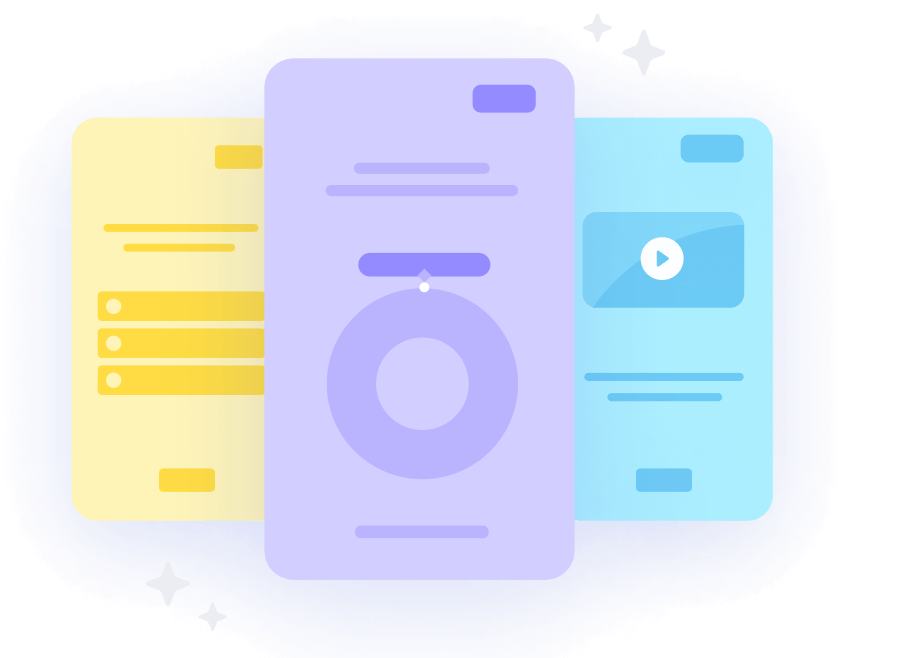Your complete guide to effective customer service training

Getting your training program right is essential for developing your customer service team’s skills. After all, your frontline employees are the face of your organization. They directly interact with your customers and shape their perceptions of your brand.
Here, we’ll explore the definition, importance, types, and steps for building an effective customer service training program. We’ll also recommend the best courses to share with your team to help you get started.
What is customer service training?
Customer service training is the process of equipping your team with the knowledge, skills, and attitudes to deliver exceptional support to your customers. The goal is to help them develop a customer-centric mindset so they can handle any customer interaction with confidence and care.
This involves teaching them how to listen to what the customer is saying, communicate in a clear and friendly way, and empathize with the customer’s needs and concerns. Training sessions typically cover customer service training topics like conflict resolution, effective communication, active listening, and problem-solving.
Why is customer service training important?
In general, training builds loyalty and trust among your team that’s important for your business to thrive. But beyond that, investing in comprehensive customer service training pays off in many other ways. Here’s why:
- It improves the customer experience: When your team knows how to communicate effectively, resolve issues, and go the extra mile, it makes a big difference in how your customers feel about your business.
- It boosts customer satisfaction and loyalty: Giving great service helps you build strong and lasting relationships with customers who are more likely to keep coming back and even recommend you to others.
- It reduces costly mistakes: Teaching your team the right processes helps lessen errors and guarantees that customers get the support they need the first time.
- It empowers your team: Training in customer service gives your employees the tools and confidence to handle job-specific situations.
- It supports your brand reputation: Delivering great customer experiences consistently allows your brand to be seen as reliable, trustworthy, and customer-focused.
Types of customer service training
The key to creating a well-rounded program is to cover all the bases. If you’re looking to tackle one topic at a time, there are many customer service training ideas and types to choose from. Here are some of them:
Product/service training
This focuses on making sure your team has a deep, comprehensive understanding of the products or services you offer. That way, they can answer customer questions accurately, troubleshoot issues, and recommend the right solutions.
Communication skills training
Developing your team’s interpersonal skills is also important for great customer interactions. Subjects like active listening, empathy, negotiation, and conflict resolution are at the core of this type of training.
Process/procedure training
Here, you’ll dive into the specific steps and protocols your team should follow when handling different customer inquiries or issues. This helps guarantee consistency and efficiency in your customer service approach.
Soft skills training
This goes beyond the technical aspects of customer service. It focuses on building up “people skills” such as problem-solving, critical thinking, and emotional intelligence to help your team deliver a more personalized, empathetic customer experience.
Role-playing exercises
These interactive, hands-on sessions allow your team to practice customer service scenarios and get feedback on their performance. It’s a great way to put their skills to the test in a safe, controlled environment.
How to create effective customer service training for employees
Now that you’ve explored the significance and different types of customer service training, it’s time to take your knowledge to the next level. To give you a clearer picture, we’ve outlined the steps, along with essential tips and best practices, to help you create your own customer service training program.
Step 1: Understand your training needs
The first step in developing an effective training program is to assess your team’s needs. This initial training needs assessment phase should involve identifying the important customer service skills, knowledge, and behaviors required for your representatives to succeed in their roles.
You may want to ask yourself questions like:
- What are the particular skills that my team has or needs to learn?
- Why is it important to train such skills?
- Do these skills align with the organization’s current goals?
- How should I measure the success of these trainings?
During this period, it’s also important to gather insights directly from your team members. This will help you spot the areas that require the most focus within your training curriculum.
Step 2: Plan the training curriculum
Next up is designing your training curriculum. You’ll want to create a comprehensive program that covers all the key areas, from product/service knowledge and communication skills to processes and soft skills. Think of it as an opportunity to build a well-rounded skill set for your team.
Once you’ve come up with your training curriculum, take advantage of a reliable learning management system (LMS) to create a structured, easy-to-navigate learning path. LMSs such as SC Training (formerly EdApp) help with this.
SC Training is a frontline training platform designed so busy employees in customer service can easily find and access the right training resources whenever they need them. By keeping everything organized and streamlined, you won’t have to worry about the nits and grits of training.
Step 3: Create engaging course content
When it comes to developing your training content, it’s essential to keep things engaging and interactive. Consider adding a variety of elements, such as videos, animations, images, games, and role-playing scenarios. The more diversity you can bring to their learning experience, the better. This will help get your team actively involved during the whole training, rather than just sitting through a ‘boring’ lecture.
Once you’ve created your course content, upload it to your frontline training platform so it’s readily available. If you want a faster route to your course creation experience, take advantage of SC Training’s intuitive creator tool. Choose from over 80 ready-made templates that include interactive and game-based elements, so you can deliver engaging training faster and hassle-free.
You can also explore the platform’s extensive course library, which has over 1,000 bite-sized courses that you can easily customize with your own branding and messaging. SC Training’s mobile-first design makes it simple for your team to revisit the material as needed, which is necessary for reinforcing new skills and behaviors.
Step 4: Include hands-on practice
For a customer-facing role, hands-on practice is crucial. So be sure to incorporate customer service simulations and feedback sessions throughout your training. It’s one thing to learn the theory, but you’d want your team to be able to put it all into practice.
Simulations and feedback are made possible through SC Training’s interactive templates. The library contains templates, such as Chat, for contextualizing training or simulating conversations. Plus, the Free Text Survey template helps gather feedback from your team so you can make changes to your lessons in real time.
Step 5: Offer ongoing support and refreshers
The learning doesn’t stop there. Ongoing check-ins, refresher training courses, and just-in-time training resources are needed to sustain your program’s effectiveness. Use your preferred LMS to deliver targeted, just-in-time training updates and resources to your employees to make sure their skills and knowledge stay fresh and up-to-date.
Step 6: Monitor and continuously improve
To wrap up, make sure to continuously monitor and improve your training program. Don’t hesitate to collect feedback from your team and analyze the data in your LMS. This will help your training remain aligned with the growing needs of your customer service team and your organization as a whole.
Use SC Training’s in-lesson discussions tool and reporting and analytics feature to track their progress and performance throughout. This way, you can identify areas where they may need extra support or guidance and use those insights to make the necessary adjustments and enhancements for your future training initiatives.
5 Recommended customer service training courses
Customer service training isn’t complete without the right resources. To help you get started, we’ve rounded up some of the top courses that can equip your team with everything they need to perform well on the job.
1. Creating a Positive Customer Experience
True customer service goes beyond being polite. It’s also largely about understanding customers’ needs and going the extra mile to make them happy. Whether your team is in retail, hospitality, or any other customer-facing role, this course offers an excellent way to kickstart your training program.
The course covers practical tips for interacting with customers in a way that builds trust and rapport. It also suggests strategies for actively engaging customers and keeping them coming back. Through a bite-sized learning approach, this course helps with learning retention and higher completion rates.
2. Customer Service: Handling Complaints
One of the toughest parts of any customer service role is dealing with unhappy customers. Designed by SC Training, this course aims to teach your team how to handle complaints in a way that leaves customers feeling heard, respected, and satisfied.
In this course, your team gets to learn proven techniques for dealing with customer complaints through listening actively and showing empathy. They’ll explore best practices for resolving issues and discover strategies for turning negative situations into positive experiences.
3. Client Value Creation
This frontline training course will show your staff how to create value for their customers to build long-lasting, profitable relationships. It tackles techniques for understanding customer needs and shaping value-led opportunities. Beyond that, it also focuses on the strategies and best practices for delivering a great customer experience through flawless execution.
4. Effective Communication in Customer Service
All great services start with effective communication. By delivering this course, your team will have the tools to communicate clearly and empathetically with their customers.
They’ll go through the art of active listening to improve their skills in assessing and understanding their customer’s needs. They’ll also discover strategies to avoid common communication barriers, such as distractions or assumptions.
5. Call Center Customer Service
This customer service course is specifically designed for call center training. By using this course, your team learns the essentials of call center etiquette - from using the right tone and voice to handling holds and transfers professionally.
The course also covers the steps of a customer call, from preparing oneself before the call to dealing with difficult customers. By the end, your team will have the techniques to handle any customer interaction confidently.
Deliver these customer service training courses and more through SC Training! Sign up today.
Author
Ella Mar
Ella is a content writer for SC Training (formerly EdApp), an award-winning e-learning management system designed to help companies deliver high-quality workplace training. In her free time, she enjoys painting, reading, or playing with her cat.
